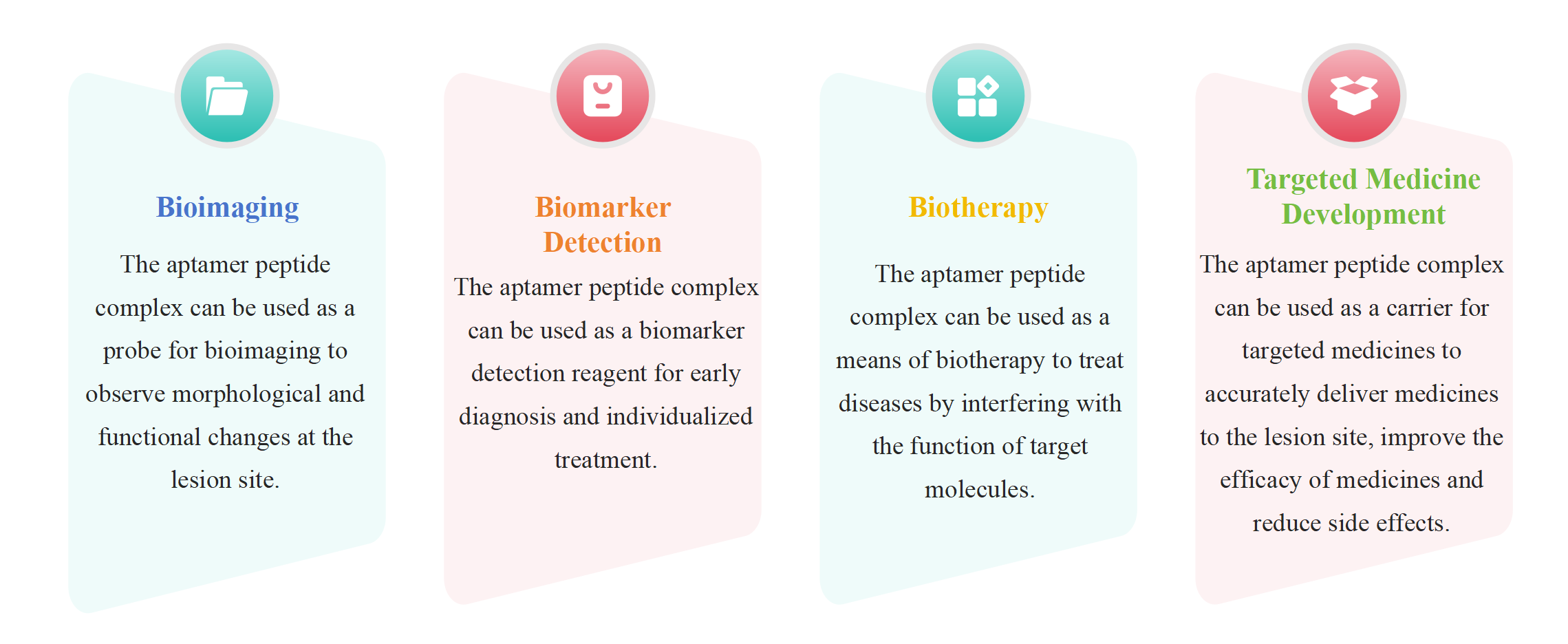2024-11-07 Hits(222)
KMD Bioscience can provide a range of services for aptamer development, SELEX screening and optimization of aptamers, which are mainly based on aptamer SELEX screening technology. The target molecules of aptamer range widely, including small molecules such as metal ions, amino acids and nucleotides, biological macromolecules such as growth factors, proteins and peptides, and even viruses, bacteria, living cells, tissue sections and living organisms. KMD Bioscience can provide suitable aptamer SELEX screening services for a variety of targets, including peptides, and continue to advance in aptamer development.
Peptides are polymers formed by covalent linkage of two or more amino acids through peptide bonds. According to the number of amino acid residues, peptides can be divided into oligopeptides (generally composed of 2 to 10 amino acids) and peptides (composed of more than 10 amino acids). Peptides have a variety of functions in organisms, such as hormones, neurotransmitters, growth factors, etc. They play an important role in regulating the physiological activities of organisms and participating in metabolic processes.
Nucleic acid aptamers obtained by screening peptides have a variety of uses. For example, based on its recognition function, it can be used as an affinity reagent to establish analytical detection methods or carry out biological imaging studies. Based on their biological activity, they can also act as antagonists to affect the normal function of target peptides at the in vivo level and block downstream signaling pathways, thereby treating diseases. In addition, aptamers can also bind to peptides to form aptamer peptide complexes, which combine the specificity of aptamers with the functionality of peptides and have broader application prospects in biomedical fields.
Aptamer Peptide
Aptamer peptide complex is a novel molecular tool that combines nucleic acid aptamers with peptides. This complex combines the specificity of a nucleic acid aptamer with the functionality of a polypeptide, resulting in higher recognition and biological activity. Aptamer peptide complexes have a wide range of applications in biomedicine.

Aptamers Screening for Peptide
Screening of aptamer
SELEX technology was used to screen aptamers from aptamer library with high specificity and affinity according to the characteristics of the targets (such as proteins and cells). The aptamer library contains a large number of single-stranded oligonucleotides.
Peptide design
According to the binding sites of the aptamer and the characteristics of the target, peptides with specific amino acid sequences were designed and synthesized.
Binding and coupling
Direct binding: In some cases, aptamer and peptide may be directly bound to form complexes through non-covalent bonds, such as hydrogen bonds, electrostatic interactions, etc.
Chemical conjugation: The aptamer and peptide are covalently linked together by chemical methods such as amide bond formation. This usually needs to be done under specific reaction conditions, such as appropriate pH, temperature and reaction time, among others.
Peptide Aptamers and Nucleic Acid Aptamers
Peptide aptamers and nucleic acid aptamers (often referred to as DNA or RNA aptamers) both play important roles in biology and medicine, but they are distinct in several ways. There are significant differences between peptide aptamers and nucleic acid aptamers in composition, structure and function, screening and synthesis, application fields, stability and transportation.

Fig.1 Structure and configuration of a peptide aptamer. ( Figure source: Binding Interactions of Peptide Aptamers. )
Constituent
Peptide aptamer: Consists of an amino acid sequence and is a specific combination of short peptide chains, usually containing 5 to 20 amino acid residues.
Nucleic acid aptamer: Consists of a DNA or RNA sequence and is a fragment of oligonucleotide obtained by in vitro screening techniques such as SELEX.
Binding mechanism
Peptide aptamers: Form stable bonds through interactions with amino acid residues of the target molecule (such as hydrogen bonding, hydrophobic interaction, ionic bonding, etc.).
Nucleic acid aptamers: Bind to target molecules through their unique three-dimensional structure (such as stem ring, pseudojunction, etc.), which may involve base pairing, electrostatic interaction and other interaction forces. Compared with antibodies, nucleic acid aptamers have a smaller volume, better thermal and chemical stability, and lower immunogenicity.
Screening and synthesis
Peptide aptamers: The screening of peptide aptamers usually involves in vivo or in vitro methods, such as phage display technology, ribosome display technology, etc. These methods can screen out peptide sequences that bind to target molecules with high affinity. The synthesis of peptide aptamers is relatively simple and can be obtained by chemical synthesis or biosynthesis.
Nucleic acid aptamers: Screening of nucleic acid aptamers is mainly performed by the SELEX screening technology, which screens sequences from nucleic acid molecular libraries for binding to target molecules. The synthesis of nucleic acid aptamers depends on the chemical synthesis technology of DNA or RNA, which has high repeatability and controllability.
Reference
[1]. Mascini M, Palchetti I, Tombelli S. Nucleic acid and peptide aptamers: fundamentals and bioanalytical aspects. Angew Chem Int Ed Engl. 2012;51(6):1316-1332.
[2]. James W. Nucleic acid and polypeptide aptamers: a powerful approach to ligand discovery. Curr Opin Pharmacol. 2001;1(5):540-546.
[3]. Tan Y, Li Y, Qu YX, et al. Aptamer-Peptide Conjugates as Targeted Chemosensitizers for Breast Cancer Treatment. ACS Appl Mater Interfaces. 2021;13(8):9436-9444.
[4]. New RRC, Bui TTT, Bogus M. Binding Interactions of Peptide Aptamers. Molecules. 2020;25(24):6055. Published 2020 Dec 21.
How to Order?

If you have any questions regarding our services or products, please feel free to contact us by E-mail: [email protected] or Tel: +86-400-621-6806